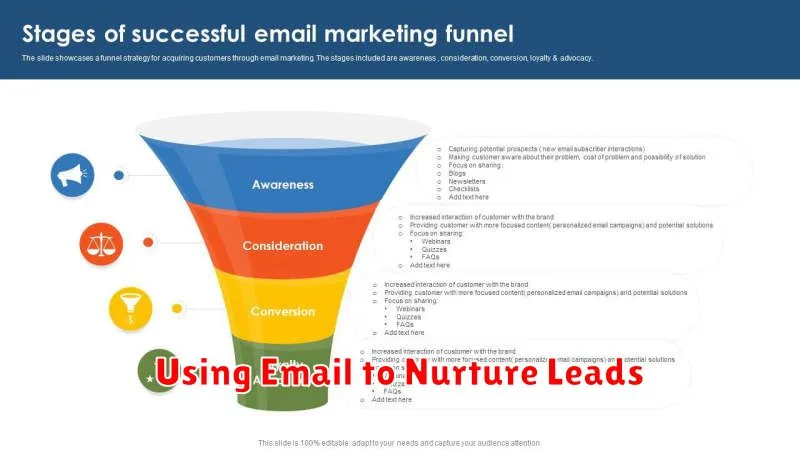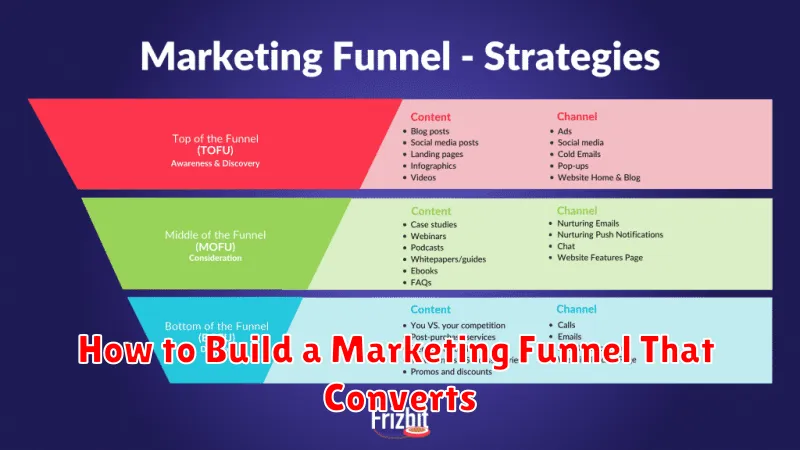In today’s competitive market, a marketing funnel is more crucial than ever for businesses aiming to attract, engage, and convert potential customers. A well-structured marketing funnel that converts acts as a strategic roadmap, guiding prospects through the various stages of the customer journey, from initial awareness to final purchase. This article will provide a comprehensive guide on how to build a high-performing marketing funnel that effectively nurtures leads and drives conversions, ultimately maximizing your return on investment.
Understanding the core components of a converting marketing funnel is essential for success. This article will delve into the key stages, including awareness, interest, desire, and action, commonly referred to as the AIDA model. We will explore practical strategies and actionable tips for optimizing each stage of your marketing funnel to ensure a seamless and persuasive customer experience, leading to increased conversions and business growth. Learn how to craft compelling content, leverage targeted advertising, and implement effective lead nurturing tactics to build a marketing funnel that converts and delivers tangible results.
What Is a Marketing Funnel?
A marketing funnel is a visual representation of the customer journey, from initial awareness to final purchase. It describes the process of guiding potential customers through various stages of engagement, ultimately leading to conversion. Think of it as a funnel where a large number of prospects enter at the top and a smaller, qualified group emerges as customers at the bottom.
Each stage of the funnel requires different marketing strategies and tactics. Understanding these stages allows businesses to tailor their messages and offerings effectively, optimizing for maximum conversion at each step.
Stages of the Funnel Explained
The marketing funnel typically comprises four key stages: Awareness, Interest, Decision, and Action.
At the Awareness stage, potential customers become aware of your brand or product. Interest follows, where they begin to actively research and engage with your offerings. The Decision stage involves evaluating options and choosing a solution. Finally, the Action stage is where the customer makes a purchase or takes the desired conversion action.
Attracting Top-of-Funnel Traffic
The top of the funnel is where you cast a wide net to capture the attention of a large audience. This stage focuses on generating awareness of your brand and piquing interest in your products or services.
Effective strategies at this stage include creating engaging content. Think blog posts, social media updates, and infographics that address your target audience’s pain points and offer valuable information. Search engine optimization (SEO) is crucial for driving organic traffic to your website.
Converting Visitors at the Middle Stage
The middle stage of the funnel focuses on nurturing leads who have shown initial interest. Engagement is key here. Provide valuable content that addresses their specific needs and pain points. This might include in-depth articles, webinars, or case studies.
Building relationships is crucial during this stage. Personalized email sequences, targeted advertising, and interactive content can foster a connection with potential customers. Offer lead magnets such as ebooks or exclusive resources in exchange for contact information to further qualify leads.
Using Email to Nurture Leads

Email marketing plays a crucial role in lead nurturing within your marketing funnel. Once a lead is captured, email allows for consistent and personalized communication.
Automated email sequences can deliver valuable content, address specific pain points, and build rapport over time. This cultivates trust and moves leads further down the funnel towards becoming paying customers.
Through targeted email campaigns, you can segment your audience and provide relevant information based on their interests and behaviors. This personalized approach strengthens engagement and increases conversion rates.
Aligning Content with Funnel Stages
Aligning your content with each stage of the marketing funnel is crucial for driving conversions. Different stages require different types of content tailored to the specific needs and interests of potential customers.
At the awareness stage, focus on educational content that addresses common pain points. The consideration stage requires more in-depth content like case studies and webinars showcasing solutions. Finally, at the decision stage, product demos and free trials can effectively nudge prospects towards a purchase.
Tracking Funnel Drop-Off Points
Identifying where prospects exit your funnel is crucial for optimization. Track key metrics at each stage, such as page views, click-through rates, and form submissions. Analyze these metrics to pinpoint areas of friction.
High drop-off rates indicate potential problems. For example, a large drop between adding items to a cart and checkout suggests issues with the payment process or shipping costs. Addressing these issues can significantly improve conversion rates.
Improving Funnel Efficiency
A crucial aspect of funnel management is ongoing optimization for efficiency. This involves minimizing drop-off rates at each stage and streamlining the customer journey. Analyze each stage of your funnel for areas of improvement. Look for bottlenecks where a significant number of potential customers abandon the process.
Common areas for improvement include simplifying forms, clarifying call-to-actions, and providing compelling content that resonates with your target audience at each stage.
Continuously monitor key metrics like conversion rates, bounce rates, and time spent on each stage. Use A/B testing to experiment with different approaches and identify the most effective strategies for optimizing your funnel’s performance.
Funnel Metrics That Matter
Tracking the right metrics is crucial for optimizing your marketing funnel. Focus on key indicators that reveal conversion rates at each stage.
Top-of-Funnel metrics include website traffic and reach of marketing campaigns. Mid-Funnel focuses on engagement such as content downloads and trial sign-ups. Bottom-of-Funnel analyzes conversions like purchases and closed deals. Analyzing these metrics allows you to identify bottlenecks and improve overall funnel performance.
Automating Your Funnel System
Once your marketing funnel is established, automation becomes key to scaling your efforts and maximizing efficiency. This involves using software and tools to handle repetitive tasks, nurturing leads, and moving them through the funnel stages.
Key areas to automate include email marketing, social media posting, lead capture forms, and even customer service interactions. Automating these aspects frees up your time to focus on strategy, content creation, and other high-value activities.

